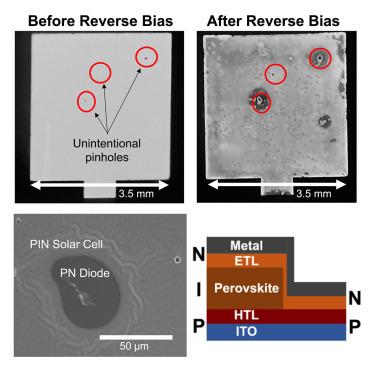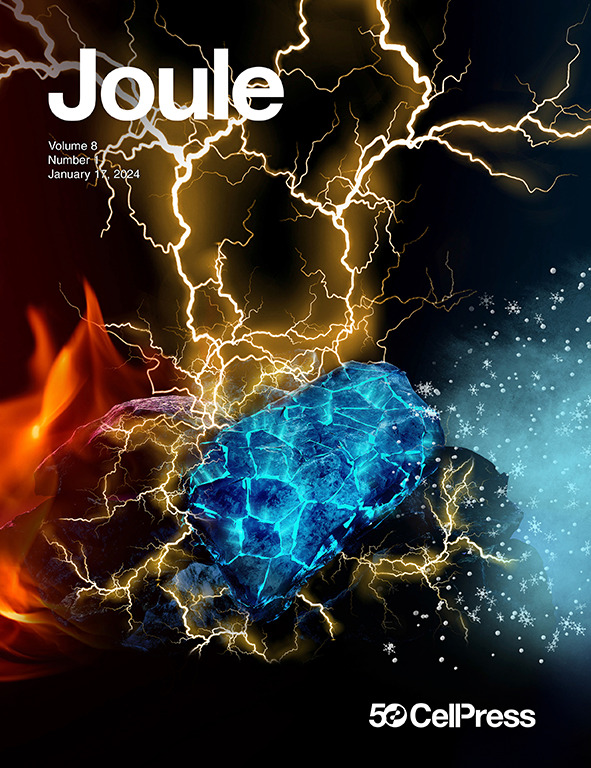钙钛矿针孔中的非欧姆接触层二极管如何影响太阳能电池的突然低压反偏击穿和破坏
IF 35.4
1区 材料科学
Q1 CHEMISTRY, PHYSICAL
引用次数: 0
摘要
钙钛矿太阳能电池(PSCs)在反向偏压下迅速降解,这种情况可能发生在部分遮光期间。在这里,我们使用电测量、电子显微镜、光学和热成像来研究低反向电位(<|−2| V)下的突然击穿和热点。我们发现,钙钛矿层中的微观针孔在反向偏压下导致快速的破坏性击穿,尽管最小程度地降低了功率转换效率。对微型(直径200微米)PSCs和无钙钛矿传输层二极管的测量表明,在纳米级到微米级的缺陷中会发生突然的低压击穿,金属迁移和成丝不太可能是原因。当钙钛矿和输运层中的针孔被消除时,反向偏置稳定性大大提高。氧化锡的原子层沉积通过确保电极之间的物理分离而不是通过阻止金属离子迁移来防止突然击穿。钙钛矿研究人员应该采用更清洁、更均匀的沉积技术,使PSCs能够进一步研究和商业应用。本文章由计算机程序翻译,如有差异,请以英文原文为准。


How non-ohmic contact-layer diodes in perovskite pinholes affect abrupt low-voltage reverse-bias breakdown and destruction of solar cells
Perovskite solar cells (PSCs) rapidly degrade under reverse bias, a condition that may occur during partial shading. Here, we use electrical measurements, electron microscopy, and optical and thermal imaging to investigate abrupt breakdown and hotspotting under low reverse potentials (<|−2| V). We show that microscopic pinholes in the perovskite layer cause rapid, destructive breakdown under reverse bias despite minimally reducing power conversion efficiencies. Measurements on miniature (200-micrometer diameter) PSCs and perovskite-free transport-layer diodes indicate that abrupt, low-voltage breakdown occurs in nanoscale to micrometer-scale defects and that metal migration and filamentation are unlikely causes. Reverse-bias stability substantially improves when pinholes in the perovskite and transport layers are eliminated. Atomic layer deposition of tin oxide prevents abrupt breakdown by ensuring physical separation between electrodes—not by blocking metal ion migration. Perovskite researchers should adopt cleaner, more uniform deposition techniques to enable robust PSCs for further research and commercial applications.
求助全文
通过发布文献求助,成功后即可免费获取论文全文。
去求助
来源期刊

Joule
Energy-General Energy
CiteScore
53.10
自引率
2.00%
发文量
198
期刊介绍:
Joule is a sister journal to Cell that focuses on research, analysis, and ideas related to sustainable energy. It aims to address the global challenge of the need for more sustainable energy solutions. Joule is a forward-looking journal that bridges disciplines and scales of energy research. It connects researchers and analysts working on scientific, technical, economic, policy, and social challenges related to sustainable energy. The journal covers a wide range of energy research, from fundamental laboratory studies on energy conversion and storage to global-level analysis. Joule aims to highlight and amplify the implications, challenges, and opportunities of novel energy research for different groups in the field.
 求助内容:
求助内容: 应助结果提醒方式:
应助结果提醒方式:


